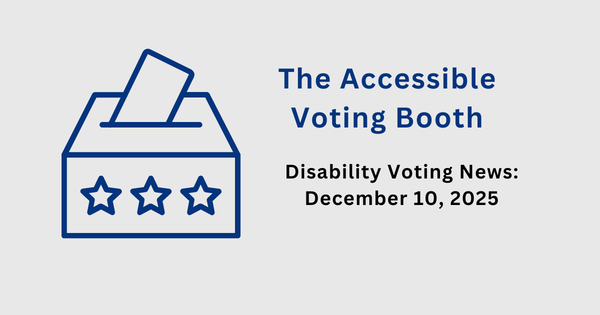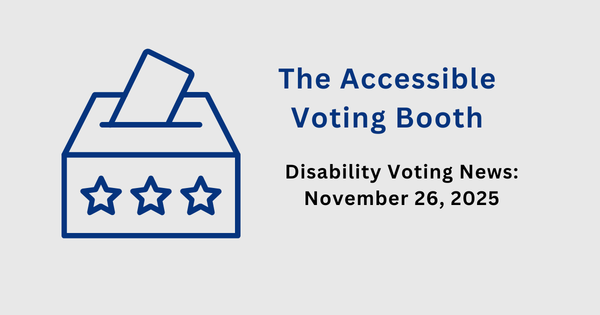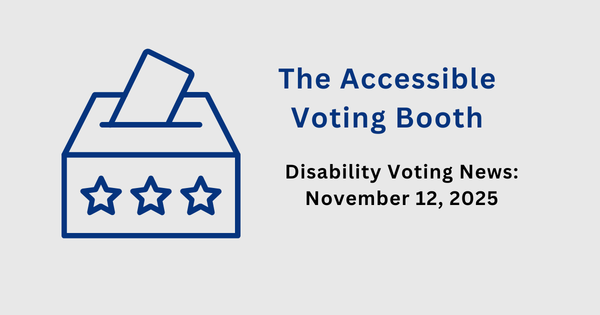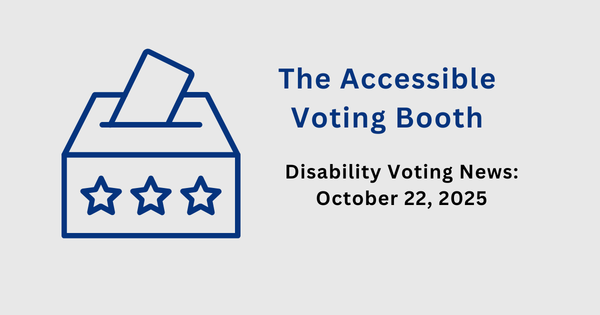Disability Voting News: April 30, 2025
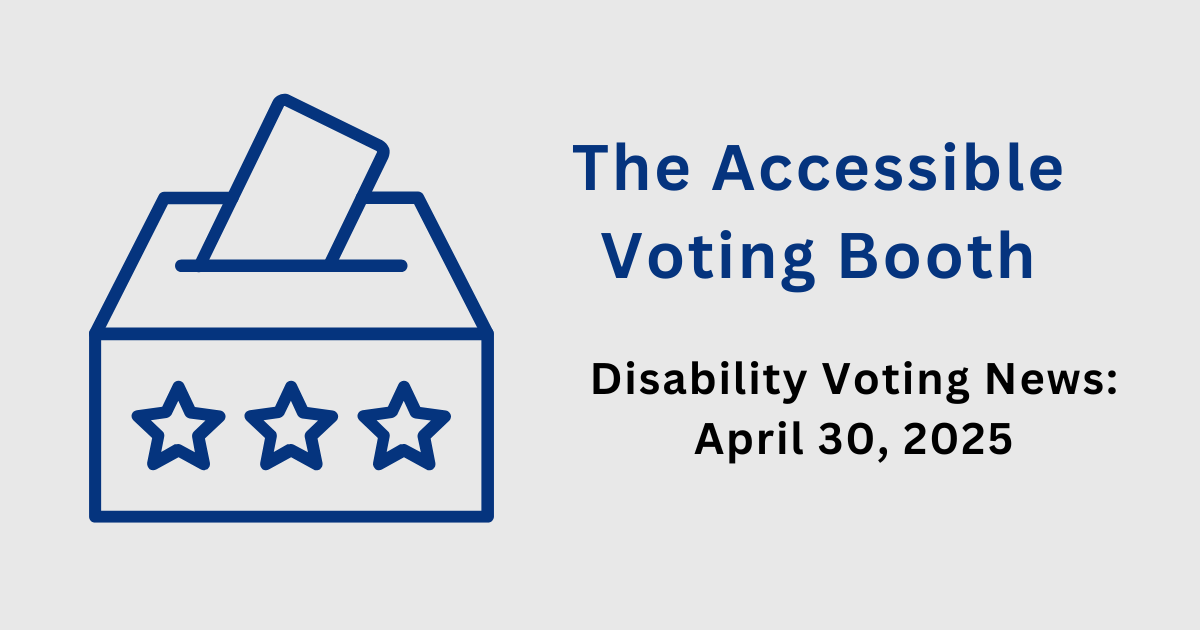
Welcome to The Accessible Voting Booth for April 30th! This week we’re going to be keeping to just two (lengthy) updates–I’ve been busy wrapping up a project that I hope to share in next week’s newsletter, if all goes to plan. This week, I thought I’d take the opportunity to dive into the somewhat spicy topic of remote electronic ballot return. Well, spicy in election terms. It’s probably one of the most controversial topics in election administration.
But before we get into that, I want to share a fantastic two-day summit happening in May dedicated to accessible voting!
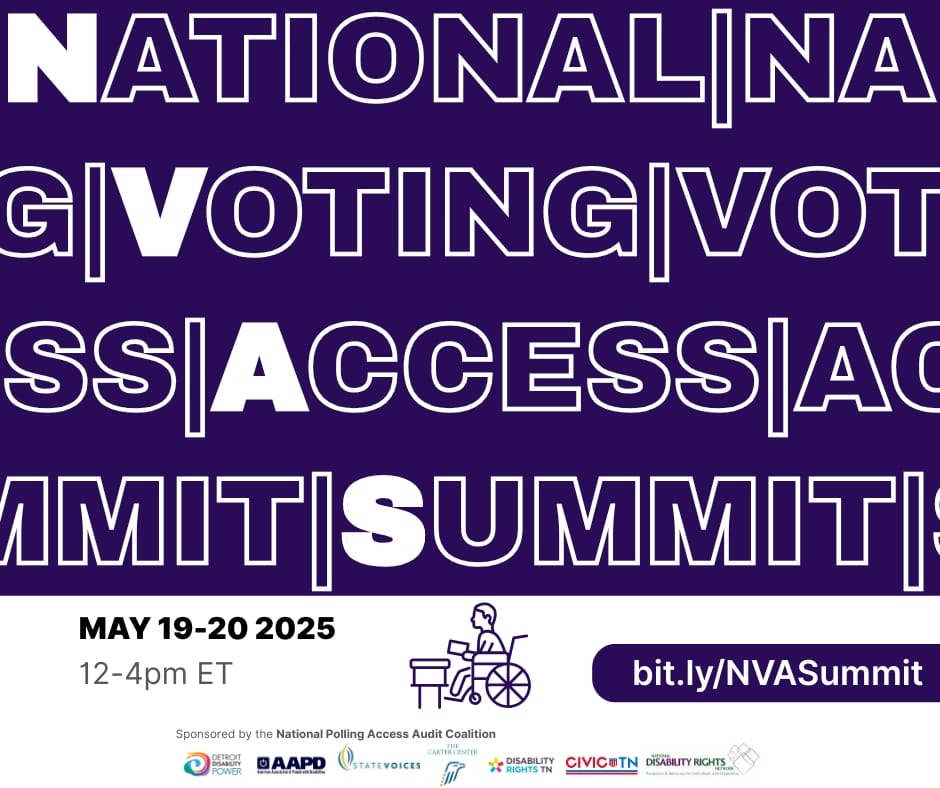
NPAAC and the National Voting Access Summit: Building a Democracy for All
Join the National Polling Access Audit Coalition on Monday, May 19 and Tuesday, May 20 for the National Voting Access Summit, a two-day virtual event that will bring together advocates, researchers, policy makers, and voting rights experts to discuss how we can make voting more accessible for all. During the summit, you’ll learn about historical trends in voting accessibility, resources to aid advocates and election officials in improving accessibility, best practices for polling place audits, storytelling and media engagement, protecting voting rights during a natural disaster, and more.
About The National Polling Access Audit Coalition
The National Polling Access Audit Coalition, or NPAAC, is a coalition of national, state, and local voting and disability rights groups that work together to support polling place accessibility audits around the country. What are accessibility audits and why are they important? During an accessibility audit, trained observers visit polling places to document accessibility barriers at the polling place.
We know that despite federal laws mandating that polling places are fully accessible, most do not meet this requirement. A 2016 audit by the U.S. Government Accountability Office found that only 17% of 167 polling places that they fully audited (both outside and inside of the polling place) were fully accessible. In 2022, Detroit Disability Power conducted an accessibility audit of 261 polling places in Metro Detroit and found that only 16% were fully accessible. Detroit Disability Power is one of the founders of NPAAC, and they have trained organizers around the country while also continuing to expand their audit program in Michigan. (Disclosure: I supported DDP’s 2022 audit and participated in writing their report through my work with The Carter Center).
A quick aside: around the country, Protection and Advocacy agencies are doing critical work to monitor polling place accessibility and follow up with election officials to remediate access barriers. Many P&As conduct polling place accessibility audits, although these look different based on the size of their state/territory and their capacity. Many, such as Delaware, West Virginia, Virginia, and Washington, DC publish their results in reports. As I explained last week, P&As and their voting accessibility work are at risk of being eliminated due to the Department of Health and Human Services’ proposed reorganization and budget cuts. If you haven’t done so, please contact your member of Congress to let them know that you oppose the elimination of P&A funding and the reorganization of the Department of Health and Human Services.
Back to accessibility audits: You can download NPAAC’s comprehensive polling place accessibility audit toolkit to learn more about how to conduct your own audits, including understanding state laws around polling place observation and how to seek authorization to observe, volunteer recruitment and training, audit tools, data templates, and worksheets to plan your audit. The upcoming National Voting Access Summit will also share information and best practices from organizations around the country that are conducting polling place accessibility audits and incorporating accessibility into their voter protection work.
Through my role as a consultant with The Carter Center, I’m thrilled to be involved in planning this National Voting Access Summit and supporting the great work of the National Polling Access Audit Coalition! American Sign Language interpretation and CART captioning will be provided. Register today at bit.ly/NVASummit. I hope to see you there!
(And an important periodic reminder since I mentioned my work: the opinions and information I share in The Accessible Voting Booth Newsletter are my own and are not representative of any organization with whom I work or am affiliated).
Montana postpones bill to allow for electronic return of ballots for voters with disabilities (via Voting Rights Lab).
Montana HB 488, which would allow voters with disabilities to return a ballot electronically in any federal primary or general election, has been postponed indefinitely as of April 22nd. If it had passed, Montana would have become one of less than a dozen states that permit voters with disabilities to return their ballots electronically. Currently, Montana does allow voters with disabilities to apply for and receive an electronic ballot that can be marked electronically, printed, and returned by mail or in person to the election office.
Electronic ballot return is perhaps one of the most controversial topics in election administration and a topic upon which disability and election advocates butt heads. Election security advocates maintain that electronic return of ballots introduces too much risk of hacking and election interference. In fact, both Democrats and Republicans have shown opposition to electronic ballot return. When Democrats introduced the For the People Act, it included a paper ballot mandate that was opposed by disability voting rights advocates. More recently, President Trump has spoken about going “back to paper ballots.” Election security advocates believe that a "voter-verifiable” paper audit trail is necessary to ensure that voters’ choices are cast correctly. Currently, the vast majority of the country votes on paper ballots, either by hand marking them or by using ballot-marking devices that can read and mark the ballot, but then print the paper ballot to be tabulated in a separate machine. Only a handful of states allow some voters with disabilities and overseas and military voters (UOCAVA) to return their ballots electronically.
However, disabled voters contend that the voting process is not fully accessible without a way to return the ballot electronically, particularly for voters who are blind or have low vision. The biggest problem lies with the fact that the “voter-verifiable” paper ballot is not, in fact, voter verifiable if you can’t see the ballot. Without a way to electronically verify and return the ballot, blind voters have to rely on others to verify the ballot for them, and potentially to cast their ballot as well. Other voters with motor disabilities may have difficulty with returning their paper ballots independently, but they could independently return them if using assistive technology to return them electronically. And while some people with disabilities may have friends, family, or community members they trust to assist them with verifying and returning their ballots, others may not. They may have to rely on people they don’t know well or people who they don’t trust enough to assist them properly. Even if voters with disabilities do have people they trust to assist them, they still deserve the right to vote privately and independently.
In the disability advocacy world, we talk about conflicting or competing access needs. These are two access needs that can’t be met at the same time because they’re in conflict. For example, someone who needs to read facial expressions during a Zoom meeting has conflicting access needs with someone who is feeling very sick and needs to have their camera off. Or, someone needs bright lighting to read or see an interpreter while another person needs low lighting due to migraine or sensory needs.
I think we can apply this concept of conflicting access needs to election technology, but in a slightly different way: conflicting security needs. Election security experts posit that electronic return of ballots is inherently risky and cannot be made secure. So, they say that ballots must have a paper audit trail that can be visually verified. Blind voters cannot visually verify their ballot, so they must rely on someone else or not verify their ballot at all. For a blind voter, is their vote truly secure if they are not able to verify their ballot and verify that it was returned for them? Is their vote secure when they are forced to rely on others and denied a private and independent vote? When a part of the election process is inaccessible to a voter with a disability, they have to rely on someone else or not participate in the election. In my opinion, that is not a secure vote for someone with a disability.
This isn’t a popular opinion in the election world, but I challenge you to keep an open mind to understanding the perspectives of voters with disabilities, and why a private and independent vote is so important to us.
Sometimes it can be easy to vilify those who we see as opposed to our goals and priorities. But I think both election security and election accessibility advocates want the same thing: a secure, accessible election process that protects the voter’s intent. We just have different perspectives on what that means and how we get there. I’m not sure what the solution is, but I hope and dream of a future where we can have elections that are both fully accessible and fully secure.
While the For the People Act/Freedom to Vote Act didn’t pass when Democrats were in power, it isn’t clear if a paper ballot mandate will show up in any of the many pieces of voting legislation that are being proposed this year. However, Montana clearly won’t be considering electronic ballot return for voters with disabilities anytime soon, as they have postponed HB 488.
Thank you for reading this week’s edition of The Accessible Voting Booth! I’ll be back next week with more updates. As always, if you’d like to support the newsletter and my work, here’s how:
- Subscribe to the Accessible Voting Booth newsletter.
- Hire me! If you or someone you know is looking to hire a disability civic engagement expert, please reach out. I’m also available for communications and administrative work through my LLC, Landmark Virtual Assistance.
- Leave me a tip. Thank you for supporting my work!
- Head over to support Disability Victory and our work in 2025.

